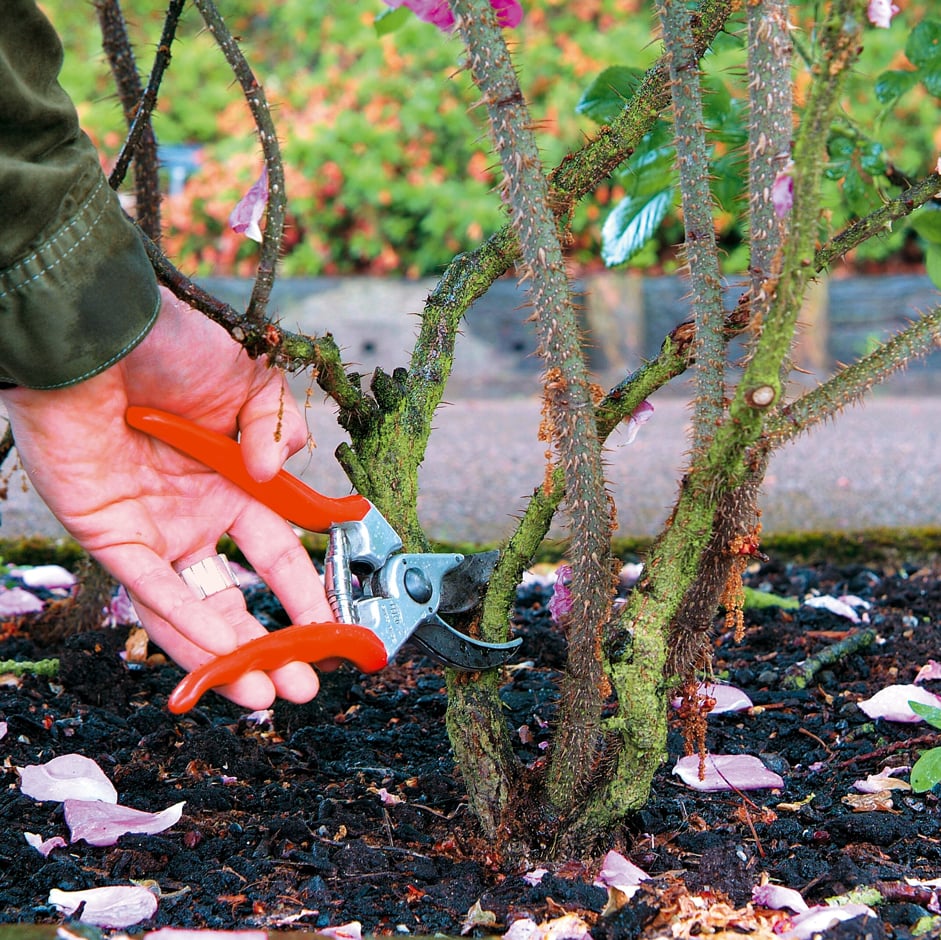Rose pruning: shrub roses
Pruning ensures that these roses grow vigorously and flower well each year. Most shrub roses require only light pruning, with exact details depending on whether it flowers just once or repeat flowers throughout the summer. These plants are in RHS Pruning Groups 20 and 21.

Quick facts
Timing: After flowering and in late winter (February to March)
Difficulty: Moderate
Suitable for...
Shrub roses are a large and diverse group of roses. They are usually larger than modern bush roses and have thornier stems, often with scented flowers. They may repeat flower or flower only once in summer. Many shrub roses are suitable for hedging as well as making excellent specimen plants.
When to prune shrub roses
Roses can be pruned during late winter when growth is just resuming, usually mid-February in the south, but in northern and colder areas wait until March.
Deadheading is carried out in summer after flowering.
How to prune shrub roses
Unlike modern bush roses, shrub roses generally flower on older wood and should be allowed to develop naturally, maintained by light but regular pruning and with a balance of older wood and young, vigorous growth.
Bear in mind that a large number of old garden roses have an arching habit and need adequate space; shortening stems simply to restrict spread spoils their graceful shape.
Shrub roses that have a single flush of flowers: pruning group 20
- Prune in late summer once flowering is completed
- The main requirement is to keep the plants free of dead, diseased and damaged wood, crossing or rubbing branches, or spindly growth
- Avoid excessive build-up of older, unproductive wood that is causing the centre to become crowded, removing one or two older branches from the centre if necessary
- If they become leggy and bare at the base, remove one or two stems back to near ground level, which will usually encourage new growth from the base
Includes: Species, Shrub and Rugosa groups; which includes ‘Fru Dagmar Hastrup’.
This method also works for: Alba, Centifolia, Damask, Gallica, Hybrid Musk, Moss, Scots and Sweet Briar groups; which includes ‘Charles de Mills’ and ‘William Lobb’.
Repeat-flowering shrub roses: pruning group 21
- Maintain a balanced framework by reducing strong new growth in late winter by up to one-third. David Austin English roses: prune back the previous season’s growths by 30 to 50 percent of their length
- Shorten strong sideshoots to two or three buds
- Mature plants require a light renewal pruning each winter by cutting some of the older main stems back to the base. This encourages vigorous new shoots from the base that will flower the following summer
- Deadhead spent blooms as they fade in the summer, to encourage production of further flowers
Includes: Bourbon, China and Portland groups, remontant roses, and David Austin English roses. These contain ‘Duchess of Portland’ and ‘Reine Victoria’.
- Rose pruning: climbing roses
- Rose pruning: hybrid tea and floribundas
- Rose pruning: groundcover roses
- Rose pruning: patio and miniature roses
- Rose pruning: rambling roses
- Rose pruning: general tips (includes a section on pruning an unknown rose)
Problems
Roses can suffer from a range of common rose problems, including replant disease, rose dieback, rose black spot, rose powdery mildew, rose rust. Insect problems include rose aphids, rose leaf rolling sawfly, rose large sawfly.
Blindness (lack of flowering) is another common issue with roses.
See also...
Get involved
The Royal Horticultural Society is the UK’s leading gardening charity. We aim to enrich everyone’s life through plants, and make the UK a greener and more beautiful place.